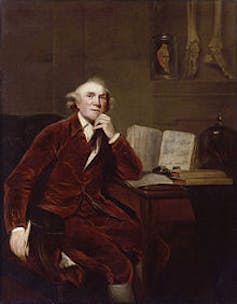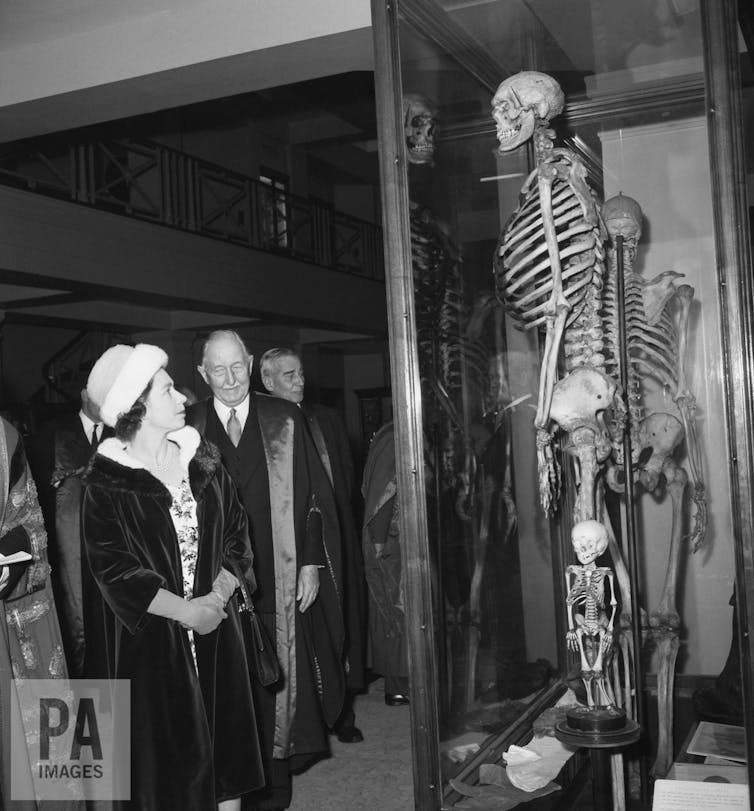
Why a London museum should return the stolen bones of an Irish giant
by Thomas L Muinzer | 9 Jun 2018 |

Except this story really happened. Fast forward to the present – and add in the London museum that refuses to give up the giant’s remains for the burial he had wished for – and the novel practically writes itself. In fact, historical novelist Hilary Mantel did just that in her 1998 novel The Giant, O'Brien.
The recently published research of human geographer Catherine Nash does an excellent job of untangling this complex story. Born in County Derry in 1761, Charles Byrne suffered from acromegalic gigantism, a condition causing him to grow to an astonishing height – his remains reveal he was around 2.3 metres tall.
Sunday died, in Cockspur Street, Charing Cross, Byrne, the famous Irish giant, whose death is reported to have been precipitated by excessive drinking, to which he was always addicted, but more particularly since his late loss of £700.When the sea burial occurred at Margate on the south coast of England, surgeon-anatomist John Hunterhad already bribed an undertaker to switch the corpse en route for dead weight and bring him the body. Afterwards, Hunter put Byrne’s skeleton on display.
Today, that skeleton remains on display in London’s Hunterian Museum, named after the surgeon himself. But as the museum undergoes a period of closure for refurbishment, campaigners are callingfor the release of the remains for burial. The Hunterian trustees have refused, arguing that the skeleton has important educational and research value.
Twist in a tall tale
My academic research with Len Doyal sparked much of the present campaign. I have since researchedthe legality of the museum’s treatment of Byrne’s skeleton, finding that while its trustees arguably are treating the remains unethically, they are not behaving unlawfully.
Nash posits that Ronan McCloskey’s 2011 BBC documentary Charles Byrne – the Irish Giant, was in fact “timed to closely follow, but not pre-empt” the publication of an important research paper involving scientific analysis of Byrne’s DNA, led by endocrinologist Marta Korbonits.
Korbonits has worked closely with the museum in her research, and does not object to the display of Byrne’s bones. Nash notes that the endocrinologist collaborated with McCloskey in making his documentary, pointing out that Korbonits acknowledges her work was “facilitated by the Hunterian Museum who gave permission for genetic material to be extracted from one of Byrne’s teeth”.
This genetic work found that Byrne had a specific gene mutation and shares genetic ancestry with people living with acromegalic gigantism in Northern Ireland today. In line with medical privacy ethics, the identities of these people were not revealed. Only one person has come forward publicly from the genetic ancestors to express views on the subject – Brendan Holland, who supports the museum’s display of Byrne’s skeleton.
But when the appropriateness of the display was challenged by the campaign, Samuel Alberti, then the director of the Hunterian Museum, fashioned an artificial narrative claiming that several of Byrne’s ancestors supported it:
Benefits of medical research conducted on Byrne’s skeleton include … the identification of shared genes between Byrne and living communities. Among these are individuals who live with the same condition, who have requested that the skeleton should remain on display.Nash finds that Holland had a long-term relationship with the department of endocrinology at Barts hospital in London, where Korbonits led her DNA research into Byrne’s genetic material. Having been treated there as a young man, Holland, Nash suggests, had fashioned himself as a “spokesperson” for the Hunterian position on retaining the exhibit that relates to his own condition. I would suggest Holland is too closely involved with the Hunterian to be considered someone speaking independently on the matter.
She also highlights that Holland collaborated with McCloskey’s documentary, and that in 2013, “anonymised extracts from a presentation that Holland delivered at a museum event were incorporated into the [Byrne] exhibition panel entitled Giant Genes”. Again, this arguably compromises Holland’s voice as an independent advocate of the Byrne display.

Thomas L Muinzer, Lecturer in Environmental Law and Public Law, University of Stirling. This article was originally published on The Conversation. Read the original article.

Sunday, June 10, 2018
The deaths this week of fashion designer Kate Spade and celebrity chef Anthony Bourdain (see below) focused the media once again on explanations for America’s rising suicide rates. The short answer is: nobody knows. The more nuanced long answer is: nobody knows for sure. But something is driving it. Here are a few paragraphs from the New York Times which suggest that suicide is becoming culturally more acceptable:
The rise of suicide turns a dark mirror on modern American society: its racing, fractured culture; its flimsy mental health system; and the desperation of so many individual souls, hidden behind the waves of smiling social media photos and cute emoticons.If this is the case, why, O why, is there a movement for assisted suicide? Yes, it’s hard to prove, but it makes sense: if assisted suicide is a triumph of compassion and autonomy, how can unassisted suicide possibly be a tragedy?
Some experts fear that suicide is simply becoming more acceptable. “It’s a hard idea to test, but it’s possible that a cultural script may be developing among some segments of our population,” said Julie Phillips, a sociologist at Rutgers.
Prohibitions are apparently loosening in some quarters, she said. Particularly among younger people, Dr. Phillips said, “We are seeing somewhat more tolerant attitudes toward suicide.”
In surveys, younger respondents are more likely than older ones “to believe we have the right to die under certain circumstances, like incurable disease, bankruptcy, or being tired of living,” she said.
 Michael Cook Editor BioEdge |
NEWS THIS WEEK
by Michael Cook | Jun 09, 2018
Dignitas founder found innocent of 'profiteering'by Michael Cook | Jun 09, 2018
A ruling by the UK Supreme Court could doom itby Michael Cook | Jun 09, 2018
“No country resorts to IVF more than Japan—or has less success”by Michael Cook | Jun 09, 2018
A clinic in Ukraine is already performing the technique and marketing it internationallyby Xavier Symons | Jun 09, 2018
Several influential doctors and ethicists have summarised the case against euthanasia.by Xavier Symons | Jun 09, 2018
US scientists say new research oversight processes have been introduced in China.IN DEPTH THIS WEEK
by Thomas L Muinzer | Jun 09, 2018
Some 250 years after his body was taken, it’s time to accord Charles Byrne the respectful burial he deservesBioEdge
Phone: +61 2 8005 8605
Mobile: 0422-691-615





















.jpg)









No hay comentarios:
Publicar un comentario